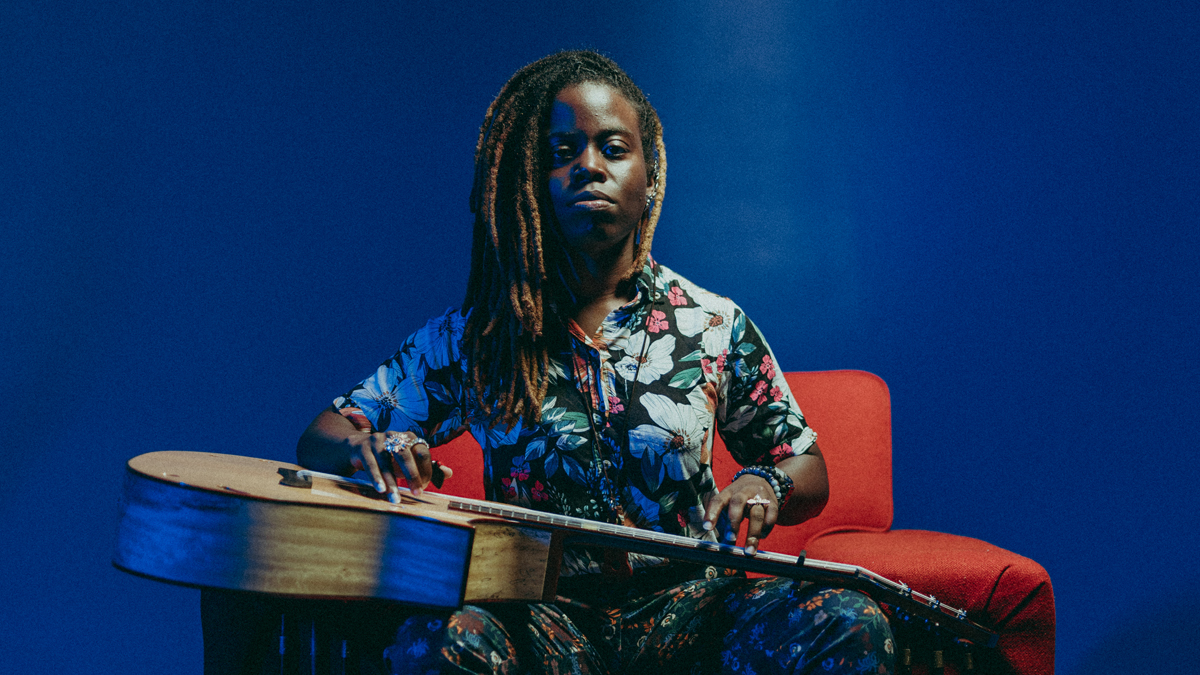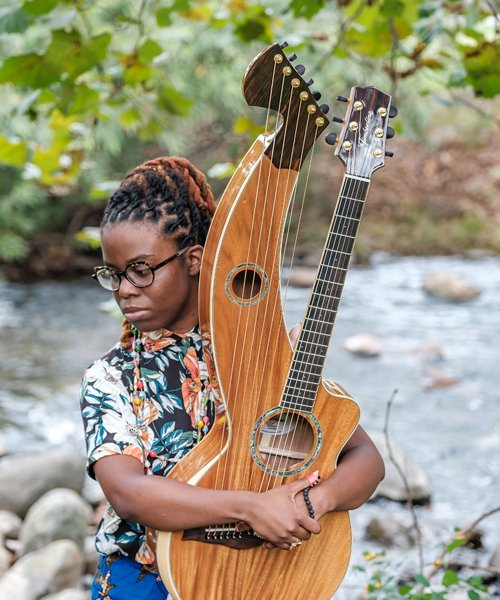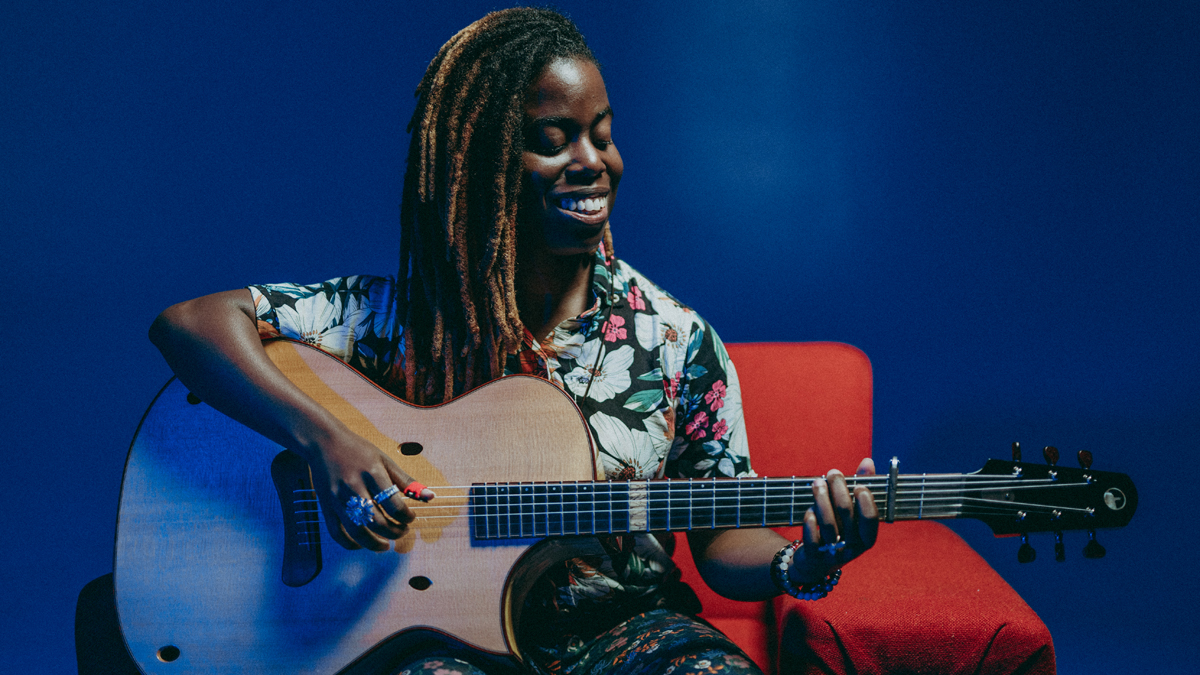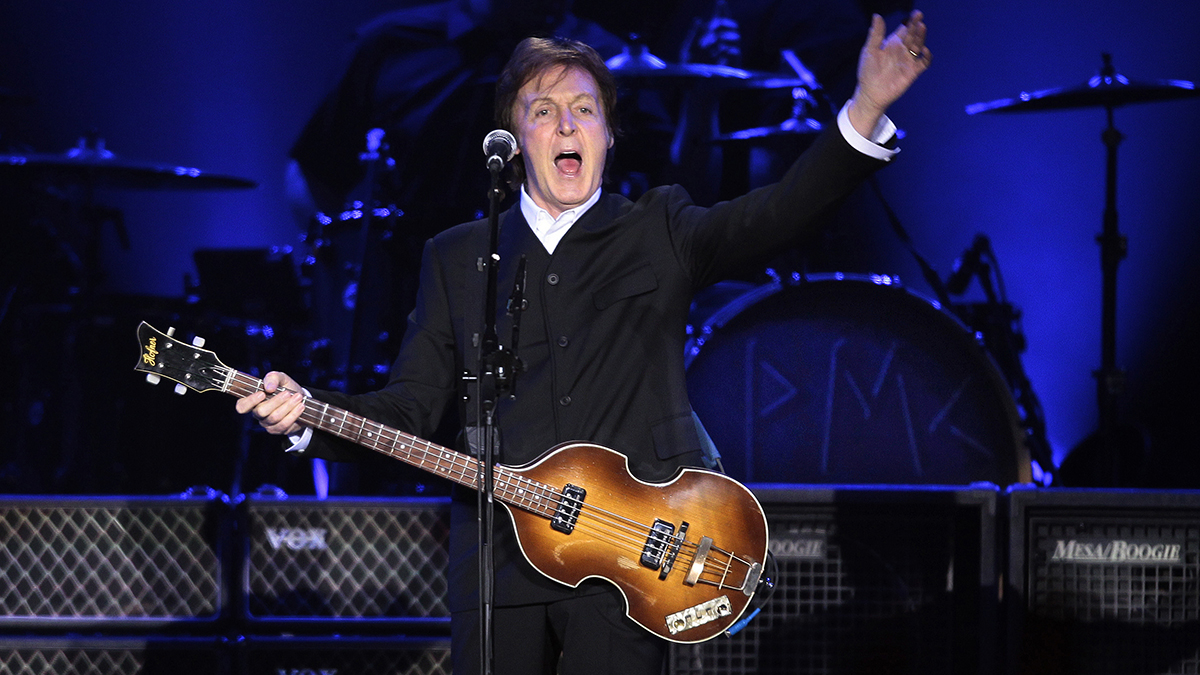Yasmin Williams: "Don’t just look at the guitar as this thing to play four chords on. They're multi-dimensional – they’re like eight instruments in one"
The acoustic fingerstyle prodigy picks apart her innovative approach to playing, breaking the boundaries of conventional acoustic technique and her eye-popping Skytop six-string

It’s impossible to forget the name Yasmin Williams once you’ve heard her music. The young Virginian’s latest album, Urban Driftwood, is a deep dive into all things ethereal, and has an almost meditative effect on its listener, thanks to her warm fingerstyle plucking and rich acoustic ambiences.
The 10 instrumental tracks, on which she plays mainly unaccompanied, also demonstrate her mastery of dynamics – turning intimate whispers into all-encompassing sound baths that thrill, amaze and soothe at the same time.
As well as her Skytop acoustic guitar, played in both upright and lap-tapping positions, Williams also wields traditional African instruments such as the kora and kalimba, and for the last year or so has been experimenting with a harp guitar, running through a pedalboard with several options for looping.
She is undoubtedly one of the most exciting rising stars in the acoustic world right now, though her guitar journey started with the dummy electric that came with her copy of Guitar Hero II...
“I beat the game and then my parents bought me an electric guitar, because I’d been asking for one for months,” she explains, speaking to Guitar World from her home in Virginia.
“That was 12 years ago now. As soon as I got it, I completely stopped playing the game and spent all my time practicing. I was doing five hours a day back then, a lot more than I do now. But yeah, it all started because of the video game. [laughs]”
Consequently, Williams’ early musical roots were more amplified and distorted than the music she’s making waves with now. Before Guitar Hero, she confesses, she hadn’t heard much rock music, but the game ignited a love for the fast, shredding guitars that quickly became her world...
All the latest guitar news, interviews, lessons, reviews, deals and more, direct to your inbox!
“Once I got playing electric, I loved bands like Nirvana and guitarists like Jimi Hendrix, as well as Paul Gilbert and Buckethead,” continues Williams. “Those were my first heroes. The latter two sounded cool because they played super-fast. I’d never heard anything like it before. I tried to emulate that for a little bit, but I can’t play like them, so I moved onto other stuff.”
You’re not alone there… Paul Gilbert’s alternate picking is as terrifying as it gets!
“I never managed to get mine to sound like that. His picking is extremely crazy! He has a ton of instructional videos out there too, and I tried a couple before realizing, ‘Nope, this probably isn’t for me!’ I have no idea how he does that stuff.”

And you mentioned Buckethead – he’s a more diverse player than many would assume, especially on albums like Colma...
“Yeah, that’s true! I saw him live because my dad bought us tickets to see him and he played a really long show. I think he played Whitewash from Colma that night. It definitely stuck out to me. Most of the other stuff he played was different – and yeah, his music is actually pretty diverse and well-rounded when you check it out. Also, his pinky is the size of my arm! It was weird to see him up close. [laughs]”
At some point you decided you were going to focus almost exclusively on acoustic sounds – how and when did that happen?
“I think pretty early on, maybe a year or a year and a half after starting. I took lessons for a few months, mainly just blues and rock stuff. Then my teacher showed me Blackbird by The Beatles. I just loved using my fingers and stopped using a pick after that.
“My teacher was like, ‘What happened?! I can’t really teach you any more fingerstyle because I’m not that kind of player!’ So I quit that. I didn’t like lessons anyway – I didn’t like being told what to do. I was a stubborn kid, I guess.
I find writing songs through lap-tapping easier, because on acoustic I’m not trying to emulate anyone. I was just playing what I wanted to play
“After that, I played acoustic exclusively, which led to lap-tapping. I find writing songs a lot easier that way, because on acoustic I’m not trying to emulate anyone or anything. I wasn’t playing covers or in anyone else’s style – I was just playing what I wanted to play.”
Which players appealed to you in terms of their acoustic work?
I didn’t care about super-crazy techniques, because it didn’t sound like a song to me. I was much more interested in songwriting… playing music rather than showing off
“When I started on acoustic I didn’t really have too many influences. I didn’t really know anyone and the music I heard, I didn’t really like. The guitar players going viral had super-crazy techniques and I didn’t care about that, because it didn’t sound like a song to me. I was much more interested in songwriting… playing music rather than showing off.
“But now, I would say I like Elizabeth Cotten a lot. Her life and career was really cool. Daniel Bachman is great. William Tyler is great. Grant Green, the jazz player, is someone I like a lot. There are a lot, I listen to so much music, it’s hard to say. Back in the day, I liked Kaki King a lot, too.”
What kind of open tunings are you using on the new album?
“Honestly, it’s mainly just one tuning I use and that’s open D, and often with a capo. On the new album, I played a lot of kora and used a guitar tuning that matched that. It’s an F tuning but I don’t remember exactly what each string is tuned to. I use a C tuning on one song, Swift Breeze, but other than that, it’s all open D, which is clearly my favorite tuning by far! [laughs]”
The opening track, Sunshowers, builds from a few simple notes into something vast and expansive. Tell us how you mastered the fingerpicking style...
“I guess I’d have to think back to how I improved. I would say try to keep your hand as relaxed as possible. That really helps, and it’s actually something I still work on even now. Sometimes, if I’m playing something difficult, my hand might lock up a little. Repetition is important – you need to play every day, even if it’s just for five minutes.
“Find exercises or make up your own exercises, that’s what I do. I didn’t use books or anything because they weren’t much fun. Find songs and then adapt them to whatever picking style you like.”

The closing track, After The Storm, has a lot of natural harmonics, which gives the song more of a 3D effect...
“I use harmonics a ton and yeah, that’s exactly how I’m trying to use them. The harmonics weren’t on that track until we got to the recording sessions, and then I decided to add them in to give more depth to the song. I use harmonics a lot because I like the ethereal quality it gives to my guitar sound.
“I love ending songs with harmonics… I don’t know why. I feel like I end all my songs with harmonics and might need to stop. [laughs] I think they sound great, so crystalline. It’s the best sound on the guitar for me, or at least one of them.”
There’s a Western folk feel to a lot of the songs, though Jarabi has more of an African flavor...
“That track came from a traditional West African song called Jarabi. The kora part I play at the beginning loops through the track. It was actually the first thing I played on the kora once I got one.
"I wanted to include it because Western Africa inspires me and influences me, especially right now, and I thought it would fit in with the record and be a nice break before the next song, which is the title track. It was nice to spice it up.”
You also play kalimba and harp guitar on that track. How do you transfer your knowledge from one instrument to the other?
I try to think of instruments as songwriting tools, rather than something I’m trying to master
“I try to think of instruments as songwriting tools, rather than something I’m trying to master. The kora sounds really nice with acoustic guitar so I try to blend the two and have found that they’re actually pretty similar.
“A lot of things I play on guitar I can transfer pretty easily... Maybe that’s just the style I play. There are some tapping guitar parts I can move onto kora and I might play it on that. And on kora, I come up with stuff that works well on guitar. They seem like very different instruments at first – the kora has 21 strings, it’s super-tall and you play with your fingers. But the essence is the same, which is probably why I like it so much.
“For other instruments like the kalimba, I’ll use them for a different voice within a track, like I did on Through the Woods. They work well with guitars, so why not?!”
How do you decide on whether to play with your acoustic upright or on your lap?
“Sometimes mid-song I might put it on my lap and switch it back up. Quite often it will be because of the rhythms, or the fact that I can’t play what I’m playing with the guitar upright. I literally have to switch it. Other times, when there are tapping sections, quite often in the bridge parts I write, I need to time my switch so it’s seamless. It’s all thought-out beforehand.”
As for the rig, we’ve seen you using a few loop stations, including the Pigtronix Infinity...
“Yeah, that one has two inputs luckily, so I can have two instruments and they can each have their own looper. The Hologram Electronics Microcosm has a micro looper, which is super cool, and I use it conjunction with the Pigtronix. So I might run all three at points, if I have to.
“I really didn’t use a looper until recently as a necessity in order to play live. Also, looping is fun! I didn’t give it a chance until recently but I’ve really enjoyed it. And it’s great for testing songs out. Now, I’m using more overdubbing in my tracks, so it’s a great way of stacking things on top of each other ahead of a studio session, just to see how it all sounds. They’re also really useful for live shows.”
And you use the Audio Sprockets ToneDexter as your main preamp?
“That’s one of the coolest pedals on the 'board, if not the coolest one. It allows my guitar to sound like it’s mic’d, even with only a pickup. I hate using mics on stage, so I don’t. What you do with the ToneDexter is plug a mic into it, play your guitar into the mic and it picks up wave maps of the guitar, which you can save as a preset.
“If I want to recall how my guitar sounds with an AKG 414, that can be preset one. If I want a 451, that can be preset two. I can recall all of these on stage and my guitar sounds mic’d, instead of just a pickup, which isn’t the best sound.
“I also use something called a Looptimus, which allows me to play synths and pads with my feet. You can do anything MIDI-related with it, but that’s what I use it for. I have a lot of stuff, but those are the main things.”

Tell us more about your main Skytop acoustic...
“Eric Weigeshoff is Skytop Guitars – it’s his company. He builds really high-end acoustics. I love his guitars because they don’t have a soundhole on the front, they have two big sound ports on the side. One goes to my left ear, the other to my right ear, so you get this super-nice stereo effect that also somehow projects really well to the audience. I don’t know how he does that!
“The guitars also look amazing – I haven’t seen anything like that from anyone else. My guitar is weird because it has holes on the front – I actually asked for that, mainly to help with lap-tapping stuff. The guitar can still project even if the sound ports are pointed at my stomach.
"The holes are natural and are made by teredo worms. These shipworms in the Pacific Northwest – I think near Alaska – eat through it, making those holes… and then Eric repurposes that wood as guitar tops. It’s pretty cool!”
What tips can you give us on sounding bigger as a solo artist, without a band backing you?
“Production helps. Knowing how to mix is good. My main guitar is great to record, though. It’s very clear and sounds like two or three instruments sometimes… It can be that huge. And yet it can also sound really intimate. I’m really picky about my guitars, I always need it to sound 3D but also more naked at times, too.
“On the record, we mainly used two small pencil mics in front of the guitar, maybe with a third larger condenser up in the air for a room sound. We also used stereo mic'ing techniques to make it sound bigger.
“I’m not usually a fan of overdubbing – I like playing one take and that being the take. I wasn’t really into the idea of throwing different parts together but it worked well in the end. There was a plate reverb that also made the guitars sound bigger, especially with the panning. But it was mainly really simple: two mics, a room and me.”
And what have been the biggest revelations on your guitar journey so far?
If you’re not thinking about guitar in a way that allows you to explore the different possibilities, you might not be sounding your best
“Don’t think of your guitar just as a stringed instrument; think of it in percussive terms, too, and as a melodic instrument – something you can bow or tap on. Don’t just look at it as this thing to play four chords on. Guitars are multi-dimensional, they’re not just for campfires. They’re like eight instruments in one.
“Expand your thinking before you even get into the techniques. If you’re not thinking about guitar in a way that allows you to explore the different possibilities, you might not be sounding your best. I do a lot of tapping, so I would have to recommend that.
"Give lap-tapping a try – it’s really not that hard. It might look a little weird but it’s not too challenging. It’s just hammer-ons and pull-offs, really. It can be fast sometimes, but the idea behind it is easy. Listen to Erik Mongrain – he’s a great player who used to lap-tap. I used to watch his videos as a kid.
“And I would say theory is important. I use a lot of 7ths and 9ths. I love open chords. I’m always adding something extra to my chords and it’s good to know what exactly. So theory should play a part in what you do, but don’t let it rule your thinking when it comes to writing and composition.”
- Urban Driftwood is available now via Spinster.
Amit has been writing for titles like Total Guitar, MusicRadar and Guitar World for over a decade and counts Richie Kotzen, Guthrie Govan and Jeff Beck among his primary influences as a guitar player. He's worked for magazines like Kerrang!, Metal Hammer, Classic Rock, Prog, Record Collector, Planet Rock, Rhythm and Bass Player, as well as newspapers like Metro and The Independent, interviewing everyone from Ozzy Osbourne and Lemmy to Slash and Jimmy Page, and once even traded solos with a member of Slayer on a track released internationally. As a session guitarist, he's played alongside members of Judas Priest and Uriah Heep in London ensemble Metalworks, as well as handled lead guitars for legends like Glen Matlock (Sex Pistols, The Faces) and Stu Hamm (Steve Vai, Joe Satriani, G3).




